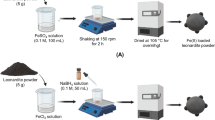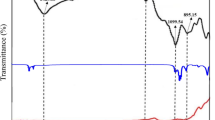Abstract
Iron anode was employed to enhance the degradation of Orange G (OG) by permanganate (EC/KMnO4). Continuously generated Fe2+ from iron anode facilitated the formation of fresh MnO2, which plays a role in catalyzing permanganate oxidation. The EC/KMnO4 system also showed a better performance to remove OG than Fe2+/KMnO4, indicating the importance of in situ formed fresh MnO2. Besides, the effects of applied current, KMnO4 dosage, solution pH, and natural organics were evaluated and results demonstrated that high current and oxidant dosage are favorable for OG removal. And the application of iron anode has a promoting effect on the KMnO4 oxidation over a wide pH range (5.0–9.0), while the Fe2+/KMnO4 process does not. For natural organics, its presence could inhibit OG removal due to its competitive role. And the promoting effect of OG removal by the EC/KMnO4 process in natural water was confirmed. At last, the EC/KMnO4 process showed a satisfying performance on the decolorization and mineralization of OG. This study provides a potential technology to enhance permanganate oxidation and broadens the knowledge of azo dye removal.





Similar content being viewed by others
References
Alventosa-deLara E, Barredo-Damas S, Zuriaga-Agustí E, Alcaina-Miranda MI, Iborra-Clar MI (2014) Ultrafiltration ceramic membrane performance during the treatment of model solutions containing dye and salt. Sep Purif Technol 129:96–105
Bakheet B, Yuan S, Li Z, Wang H, Zuo J, Komarneni S, Wang Y (2013) Electro-peroxone treatment of Orange II dye wastewater. Water Res 47:6234–6243
Berberidou C, Poulios I, Xekoukoulotakis NP, Mantzavinos D (2007) Sonolytic, photocatalytic and sonophotocatalytic degradation of malachite green in aqueous solutions. Appl Catal B Environ 74:63–72
Brillas E, Martínez-Huitle CA (2015) Decontamination of wastewaters containing synthetic organic dyes by electrochemical methods. An updated review. Appl Catal B Environ 166:603–643
Du J, Sun B, Zhang J, Guan X (2012) Parabola-like shaped pH-rate profile for phenols oxidation by aqueous permanganate. Environ Sci Technol 46:8860–8867
Freeman F, Kappos JC (1985) Permanganate ion oxidations. 15. Additional evidence for formation of soluble (colloidal) manganese dioxide during the permanganate ion oxidation of carbon-carbon double bonds in phosphate-buffered solutions. J Am Chem Soc 107:6628–6633
Govindan K, Raja M, Noel M, James EJ (2014) Degradation of pentachlorophenol by hydroxyl radicals and sulfate radicals using electrochemical activation of peroxomonosulfate, peroxodisulfate and hydrogen peroxide. J Hazard Mater 272:42–51
Hoigné J, Bader H (1994) Kinetics of reactions of chlorine dioxide (OClO) in water—I. Rate constants for inorganic and organic compounds. Water Res 28:45–55
Jiang J-Q, Lloyd B (2002) Progress in the development and use of ferrate (VI) salt as an oxidant and coagulant for water and wastewater treatment. Water Res 36:1397–1408
Jiang J, Pang S-Y, Ma J (2009) Oxidation of triclosan by permanganate (Mn (VII)): importance of ligands and in situ formed manganese oxides. Environ Sci Technol 43:8326–8331
Jiang J, Pang S-Y, Ma J (2010) Role of ligands in permanganate oxidation of organics. Environ Sci Technol 44:4270–4275
Jiang J, Gao Y, Pang S-Y, Lu X-T, Zhou Y, Ma J, Wang Q (2015) Understanding the role of manganese dioxide in the oxidation of phenolic compounds by aqueous permanganate. Environ Sci Technol 49:520–528
Ma J, Graham N, Li G (1997) Effect of permanganate preoxidation in enhancing the coagulation of surface waters-laboratory case studies. Aqua 46:1–10
Martínez-Huitle CA, Brillas E (2009) Decontamination of wastewaters containing synthetic organic dyes by electrochemical methods: a general review. Appl Catal B Environ 87:105–145
Pang YL, Lim S, Ong HC, Chong WT (2016) Synthesis, characteristics and sonocatalytic activities of calcined γ-Fe2O3 and TiO2 nanotubes/γ-Fe2O3 magnetic catalysts in the degradation of Orange G. Ultrason Sonochem 29:317–327
Perez-Benito JF, Arias C, Amat E (1996) A kinetic study of the reduction of colloidal manganese dioxide by oxalic acid. J Colloid Interf Sci 177:288–297
Rodríguez E, Majado ME, Meriluoto J, Acero JL (2007) Oxidation of microcystins by permanganate: reaction kinetics and implications for water treatment. Water Res 41:102–110
Rule KL, Ebbett VR, Vikesland PJ (2005) Formation of chloroform and chlorinated organics by free-chlorine-mediated oxidation of triclosan. Environ Sci Technol 39:3176–3185
Salima A, Benaouda B, Noureddine B, Duclaux L (2013) Application of Ulva lactuca and Systoceira stricta algae-based activated carbons to hazardous cationic dyes removal from industrial effluents. Water Res 47:3375–3388
Savin I-I, Butnaru R (2008) Wastewater characteristics in textile finishing mills. Environ Eng Manag J 7:859–864
Sharma KP, Sharma S, Sharma S, Singh PK, Kumar S, Grover R, Sharma PK (2007) A comparative study on characterization of textile wastewaters (untreated and treated) toxicity by chemical and biological tests. Chemosphere 69:48–54
Sun B, Zhang J, Du J, Qiao J, Guan X (2013) Reinvestigation of the role of humic acid in the oxidation of phenols by permanganate. Environ Sci Technol 47:14332–14340
Sun B, Guan X, Fang J, Tratnyek PG (2015) Activation of manganese oxidants with bisulfite for enhanced oxidation of organic contaminants: the involvement of Mn (III. Environ Sci Technol 49:12414–12421
Szpyrkowicz L, Juzzolino C, Kaul SN (2001) A comparative study on oxidation of disperse dyes by electrochemical process, ozone, hypochlorite and Fenton reagent. Water Res 35:2129–2136
Tsang DCW, Hartley NR (2014) Metal distribution and spectroscopic analysis after soil washing with chelating agents and humic substances. Environ Sci Pollut Res 21:3987–3995
Von Gunten U (2003a) Ozonation of drinking water: part I. Oxidation kinetics and product formation. Water Res 37:1443–1467
Von Gunten U (2003b) Ozonation of drinking water: part II. Disinfection and by-product formation in presence of bromide, iodide or chlorine. Water Res 37:1469–1487
Wu H, Wang S (2012) Impacts of operating parameters on oxidation–reduction potential and pretreatment efficacy in the pretreatment of printing and dyeing wastewater by Fenton process. J Hazard Mater 243:86–94
Xie P, Ma J, Fang J, Guan Y, Yue S, Li X, Chen L (2013) Comparison of permanganate preoxidation and preozonation on algae containing water: cell integrity, characteristics, and chlorinated disinfection byproduct formation. Environ Sci Technol 47:14051–14061
Xiong X, Sun B, Zhang J, Gao N, Shen J, Li J, Guan X (2014) Activating persulfate by Fe0 coupling with weak magnetic field: performance and mechanism. Water Res 62:53–62
Xu X-R, Li X-Z (2010) Degradation of azo dye Orange G in aqueous solutions by persulfate with ferrous ion. Sep Purif Technol 72:105–111
Yuan SH, Liao P, Alshawabkeh AN (2014) Electrolytic manipulation of persulfate reactivity by iron electrodes for trichloroethylene degradation in groundwater. Environ Sci Technol 48:656–663
Yüksel E, Sengil IA, Özacar M (2009) The removal of sodium dodecyl sulfate in synthetic wastewater by peroxi-electrocoagulation method. Chem Eng J 152:347–353
Zhang H, Huang C-H (2003) Oxidative transformation of triclosan and chlorophene by manganese oxides. Environ Sci Technol 37:2421–2430
Zhang S-J, Yu H-Q, Zhao Y (2005) Kinetic modeling of the radiolytic degradation of Acid Orange 7 in aqueous solutions. Water Res 39:839–846
Zhou S, Shao Y, Gao N, Li L, Deng J, Zhu M, Zhu S (2014a) Effect of chlorine dioxide on cyanobacterial cell integrity, toxin degradation and disinfection by-product formation. Sci Total Environ 482–483:208–213
Zhou S, Shao Y, Gao N, Zhu S, Li L, Deng J, Zhu M (2014b) Removal of Microcystis aeruginosa by potassium ferrate (VI): impacts on cells integrity, intracellular organic matter release and disinfection by-products formation. Chem Eng J 251:304–309
Acknowledgments
This work was financially supported by the National Natural Science Foundation (51508174).
Author information
Authors and Affiliations
Corresponding author
Additional information
Responsible editor: Santiago V. Luis
Electronic supplementary material
ESM 1
(DOCX 9682 kb)
Rights and permissions
About this article
Cite this article
Bu, L., Shi, Z. & Zhou, S. Enhanced degradation of Orange G by permanganate with the employment of iron anode. Environ Sci Pollut Res 24, 388–394 (2017). https://doi.org/10.1007/s11356-016-7777-8
Received:
Accepted:
Published:
Issue Date:
DOI: https://doi.org/10.1007/s11356-016-7777-8




